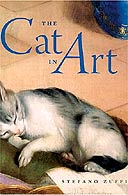Stefano Zuffi est un historien de l'art italien né le 24 mai 1961 à Milan. He has published over 100 titles. The Guardian reviewed one on cats, which we quote:
Stefano Zuffi's The Cat in Art looks at how depicting the feline has engrossed artists for millennia. ....

'....Stefano Zuffi, who has scoured the entire history of art from ancient Egypt to Picasso, wastes little time in issuing a warning. "According to a Persian legend," he writes, "the cat was born of a lion's sneeze." So we must never be deceived by the purring of a placid pussy. Zuffi points out that the transition from wild feline to domestic pet occurred many centuries ago, when cats emerged from the undergrowth of the Nile valley. But even the benevolent cat-goddess Bastet, shown suckling her kittens in countless Egyptian bronzes, may not be entirely admirable. PG Wodehouse once declared that "Cats, as a class, have never completely got over the snootiness caused by the fact that in Ancient Egypt they were worshipped as gods."
'Their divine status did not survive in the Roman era. By the time a cat was depicted in a floor mosaic made for the celebrated House of the Faun in Pompeii, it had become a wild-eyed predator. With claws already sunk deep into a hapless partridge, the ravenous animal also stares down eagerly at the tempting ducks and shellfish assembled below.
'The rise of Christianity generated a strangely complex, almost bipolar attitude towards cats. At one extreme, they were seen in Poitiers cathedral's choir-stall carvings as agents of providence, attacking mice bent on gnawing at the roots of the tree of life. But this image was countered by the medieval notion that cats were in league with the devil. They became the witch's animal, the Knights Templar were accused of heresy in the form of cat worship and Pope Innocent VIII decreed that cats had become Satan's favourite helpers. Hence the appalling decision to initiate a superstitious cat festival in Ypres where the persecuted animals were hurled from the tower of the Gothic town hall....
'So it is a relief to escape from these horrors and find, in the Renaissance, a more enlightened attitude developing. True, cats are sometimes placed next to Judas in paintings of the Last Supper. But this agent of betrayal is replaced by a far more reassuring animal in Jan Van Eyck's Birth of John the Baptist. Here, a cat ignores the momentous event and gazes, with greedy longing, at a bowl of fruit rashly abandoned on the floor. Domesticated pets crop up in an astonishing number of the greatest Renaissance paintings. If we search carefully enough, cats can be discerned dozing in canvases by artists as diverse as Tintoretto and Bosch. Right at the forefront of Veronese's giant panorama The Wedding at Cana, a grey cat rolls over on its back and paws at the pitcher where water has just been transformed into miraculous wine....'
This is just the start of a wonderful book.
1 comment:
Cats have certainly gnereated a great deal of controversy throughout the ages-probably on purpose. But they always inspired artisitic interpretation. Mysterious and inscrutable, they always exude a regal aura.Zuffi's book must be fabulous.
Post a Comment